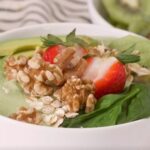Embrace the vibrant hues and fresh flavors of spring with a collection of delightful vegan recipes. Imagine plates bursting with the jewel-toned greens of asparagus, the sunny yellow of peas, and the bright crimson of strawberries, all harmoniously arranged to create a feast for the eyes and the palate. This culinary journey explores the season’s bounty, transforming simple, fresh ingredients into innovative and satisfying vegan dishes, from vibrant salads to hearty main courses and light, spring-inspired desserts. Each recipe is crafted with a focus on both taste and visual appeal, making these dishes perfect for sharing with loved ones or simply enjoying a moment of mindful culinary appreciation.
We’ll delve into the nutritional benefits and unique flavor profiles of quintessential spring vegetables, guiding you through the art of selecting and using fresh herbs to maximize their aromatic impact. Discover adaptable recipes that cater to various dietary needs, along with expert tips and techniques to elevate your vegan cooking to the next level. Prepare to be inspired by the simplicity and elegance of spring-fresh vegan cuisine.
Spring-Inspired Vegan Main Courses

Spring offers a bounty of vibrant, fresh produce perfect for creating delicious and satisfying vegan main courses. These recipes highlight the season’s best ingredients, resulting in dishes that are both flavorful and visually appealing. Each recipe can be easily adapted to suit various dietary needs and preferences, ensuring everyone can enjoy the deliciousness of spring.
Asparagus and Lemon Risotto with Toasted Pine Nuts
This creamy risotto showcases the delicate flavor of spring asparagus, brightened by the zestiness of lemon and the satisfying crunch of toasted pine nuts. The earthy asparagus perfectly complements the creamy rice, creating a harmonious balance of textures and tastes.
| Ingredient | Quantity |
|---|---|
| Arborio rice | 1 cup |
| Vegetable broth | 4 cups |
| Asparagus, trimmed and chopped | 1 bunch |
| White wine | 1/2 cup |
| Lemon, zested and juiced | 1 |
| Pine nuts | 1/4 cup |
| Nutritional yeast | 2 tablespoons |
| Garlic, minced | 2 cloves |
| Olive oil | 2 tablespoons |
| Salt and pepper | To taste |
- Toast pine nuts in a dry pan until golden brown. Set aside.
- Sauté garlic in olive oil until fragrant. Add rice and toast for 2 minutes.
- Deglaze with white wine, allowing it to reduce slightly.
- Add a ladle of broth at a time, stirring continuously until absorbed before adding more. Continue until rice is creamy and al dente.
- Stir in asparagus, lemon zest, lemon juice, and nutritional yeast. Season with salt and pepper.
- Serve topped with toasted pine nuts.
To make this recipe gluten-free, ensure your vegetable broth is gluten-free. For a nut-free version, substitute sunflower seeds for the pine nuts. For optimal texture, use high-quality Arborio rice and don’t overcook the asparagus. The vibrant green color of the asparagus should be maintained.
Spring Pea and Mint Pasta with Lemon-Garlic Sauce
This pasta dish bursts with fresh, spring flavors. Sweet peas, fragrant mint, and a zesty lemon-garlic sauce combine to create a light yet satisfying meal. The vibrant green color and fresh aroma make it a visually appealing and delicious choice.
| Ingredient | Quantity |
|---|---|
| Pasta (gluten-free if needed) | 1 pound |
| Fresh or frozen peas | 1 cup |
| Fresh mint, chopped | 1/4 cup |
| Lemon, zested and juiced | 1 |
| Garlic, minced | 2 cloves |
| Olive oil | 2 tablespoons |
| Vegan parmesan cheese (optional) | 1/4 cup |
| Salt and pepper | To taste |
- Cook pasta according to package directions.
- While pasta cooks, sauté garlic in olive oil until fragrant.
- Add peas and cook until tender-crisp.
- Stir in lemon zest, lemon juice, and mint. Season with salt and pepper.
- Drain pasta and add it to the sauce. Toss to combine.
- Serve topped with vegan parmesan cheese (optional).
This recipe is easily adaptable. Use gluten-free pasta for a gluten-free option. Omitting the vegan parmesan makes it dairy-free. To enhance the mint flavor, add a few extra mint leaves just before serving.
Roasted Carrot and Chickpea Salad with Harissa Dressing
This vibrant salad features roasted carrots, chickpeas, and a flavorful harissa dressing. The sweetness of the roasted carrots complements the spice of the harissa, creating a balanced and exciting flavor profile. The contrasting textures of the tender carrots and crunchy chickpeas add to the overall enjoyment.
| Ingredient | Quantity |
|---|---|
| Carrots, chopped | 1 pound |
| Chickpeas, drained and rinsed | 1 can |
| Harissa paste | 2 tablespoons |
| Olive oil | 2 tablespoons |
| Lemon juice | 1 tablespoon |
| Maple syrup | 1 tablespoon |
| Cumin | 1 teaspoon |
| Salt and pepper | To taste |
| Fresh parsley, chopped | 1/4 cup |
- Preheat oven to 400°F (200°C).
- Toss carrots with olive oil, cumin, salt, and pepper. Roast for 20-25 minutes, until tender.
- While carrots roast, whisk together harissa paste, lemon juice, and maple syrup.
- Combine roasted carrots, chickpeas, and harissa dressing. Toss gently.
- Serve garnished with fresh parsley.
For a milder flavor, reduce the amount of harissa paste. Adding other roasted vegetables, such as sweet potatoes or bell peppers, adds variety. Roasting the carrots until slightly caramelized enhances their sweetness and flavor.
From the earthy sweetness of spring vegetables to the bright, herbaceous notes of fresh herbs, this collection of vegan recipes captures the essence of the season. We’ve explored diverse culinary possibilities, demonstrating how simple, seasonal ingredients can transform into stunning and flavorful dishes. Whether you’re a seasoned vegan chef or just beginning your culinary journey, these recipes offer a refreshing and inspiring approach to spring cooking, encouraging you to experiment with vibrant colors, textures, and tastes. So, gather your ingredients, embrace the season’s bounty, and embark on a culinary adventure filled with fresh flavors and the joy of creating delicious, healthy vegan meals.
FAQ Summary
Can I substitute ingredients in these recipes?
Many substitutions are possible depending on dietary needs and preferences. The recipes offer suggestions for gluten-free and nut-free adaptations, but feel free to experiment with other vegetables, herbs, and fruits based on availability and personal taste.
How long can I store the prepared dishes?
Storage times vary depending on the recipe. Salads are best enjoyed fresh, while main courses and desserts can often be stored in the refrigerator for 2-3 days. Always ensure proper refrigeration and check for freshness before consuming.
Where can I find the freshest spring ingredients?
Farmers’ markets are an excellent source for seasonal produce and herbs. Look for vibrant colors, firm textures, and fresh aromas to ensure optimal quality.
Are these recipes suitable for beginners?
Yes! The recipes are designed to be accessible to cooks of all skill levels. The step-by-step instructions and clear explanations make them easy to follow, even for beginners.


